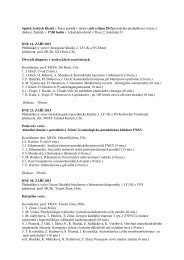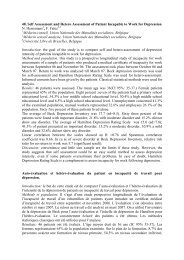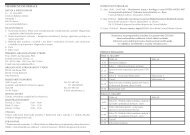ABSTRACTS â ORAL PRESENTATIONS - AMCA, spol. s r.o.
ABSTRACTS â ORAL PRESENTATIONS - AMCA, spol. s r.o.
ABSTRACTS â ORAL PRESENTATIONS - AMCA, spol. s r.o.
Create successful ePaper yourself
Turn your PDF publications into a flip-book with our unique Google optimized e-Paper software.
P38. EVIDENCE OF ABNORMAL PERIPHERAL CYTOKINE PROFILE IN PORCINE MODEL<br />
OF HUNTINGTON’S DISEASE<br />
Ivona Valekova 1,3 , Jiri Klima 1 , Helena Kupcova Skalnikova 2 , Karla Jarkovska 2 ,<br />
Stefan Juhas 1 , Jan Motlik 1<br />
1<br />
Laboratory of Cell Regeneration and Plasticity, Institute of Animal Physiology and<br />
Genetics, v.v.i., AS CR, Libechov, Czech Republic;<br />
2<br />
Laboratory of Biochemistry and Molecular Biology of Germ Cells, Institute of Animal<br />
Physiology and Genetics, v.v.i., AS CR, Libechov, Czech Republic;<br />
3<br />
Department of Cell Biology, Faculty of Science, Charles University in Prague, Prague,<br />
Czech Republic<br />
valekova@iag.cas.cz<br />
Huntington´s disease (HD) is a devastating monogenic neurodegenerative disorder with<br />
detrimental effects of abnormal expansion of the CAG trinucleotide repeat within the<br />
coding region of the huntingtin gene. HD is characterized by brain neurodegeneration<br />
with a loss of brain neurons located predominantly in the striatum. The disease onset<br />
is in the middle age and is generally marked by progressive cognitive, psychiatric and<br />
motor impairment. Currently, there is no HD treatment available.<br />
Although HD causes widespread changes in CNS, there is a parallel immune activation in<br />
the periphery. The pro-inflammatory cytokine levels are increased earliest in the disease<br />
course, long before the onset of motor dysfunction. This phenomenon can be observed<br />
many years before the predicted onset of neurological symptoms (Björkvist et al., 2008),<br />
which designates immune activation as a potential biomarker of HD progression.<br />
The early disease progression is monitored on unique minipig model. In our lab we have<br />
recently generated a biomedical model of HD - a miniature pig transgenic for N-terminal<br />
part of the mutated human huntingtin (mt HTT, 548aa, 124Q) (Baxa et al., 2013). Agematched<br />
control and HD transgenic minipigs with the same genetic background were<br />
included in this study.<br />
The principal aims of this study are (i) to characterize the activation of innate immune<br />
system in control and HD transgenic animals, (ii) to monitor the levels of cytokines<br />
during ageing and disease course, (iii) to detect monocyte activation as a possible source<br />
of peripheral cytokines.<br />
The expression of selected thirteen cytokines, chemokines and growth factors were<br />
examined by targeted proteomic profiling using cytometric approaches. Isolated<br />
non-mature CD14+ monocytes were activated and analyzed using porcine Luminex<br />
immunoassay.<br />
Our data indicate significant changes between control and HD transgenic miniature<br />
pigs mainly in the level of IL-8, both in blood serum and monocytes in the age of 13-<br />
15 months. The cytokine profiling together with monitoring of monocyte activation is<br />
regularly continuing in three month intervals.<br />
Early changes identified in HD transgenic pigs may help to clarify the pathological<br />
mechanisms underlying the disease development, and thus could offer an obtainment<br />
of accessible non-invasive bioindicators of disease progress.<br />
132 Analytical Cytometry VII








